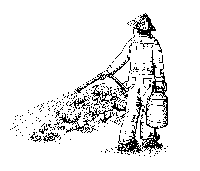Proper use of pesticides is essential for your safety and for that of the
environment. And, pesticides must be properly used to be effective.
Review the product label before each use. Be sure you have all the materials
necessary for a safe and proper application. Check precautions label sites
(e.g., types of plants or areas); and timing requirements such as days to
harvest, temperature, and wind speed restrictions. Be sure you can indeed use
this pesticide when and where you intend to!
When applying pesticides, wear the protective clothing and use the equipment
the label requires. To prevent spillage of chemicals, always check application
equipment for leaking hoses or connections and plugged, worn, or dripping
nozzles before adding pesticide. Before applying, clear all people, pets, and
livestock from the area.
Return to Table of Contents
The same sprayer equipment should not be used for both weed control and
insect control. No matter how well a tank is rinsed after use of some
herbicides, a residue can be left in the tank and in the gaskets, hoses, and
parts. If the same tank is then used with an insecticide to spray a plant, it is
possible to kill or injure the plant with the herbicide residue. The safest
policy is to maintain two sprayers-one for herbicides and another for
insecticides and fungicides. Have them clearly labeled according to use. Always
clean equipment after each use.
A wide variety of pesticide application equipment is available, including
sprayers, dusters, and granular applicators. Many pesticides are available
ready-to-use, in containers that also serve as applicators (aerosols, spray
bottles, canister dusters). Hose-end application devices are not recommended
because they provide only limited control over the application rate, and because
of the possibility of contarninating the local water supply through back
siphoning.
Return to Table of Contents
Read the label carefully. If mixing is required, use the recommended
proportions-measure carefully; mix thoroughly. If the label recommends a
spreader/sticker, or other additive, use one.
Return to Table of Contents
Care should be taken to avoid the potential for drift, or off-target movement
in the air. To minimize particle drift, apply pesticides when winds are calm.
Mornings and evenings are usually good times. If a moderate breeze picks up
while you are spraying, stop working. You can reduce spray drift by using low
pressure, a large nozzle (large droplets), and anti-drift additives.
Vapor drift occurs when a pesticide evaporates from a sprayed surface.
Drifting vapors can travel some distance and cause injury! You can minimize
vapor drift by avoiding products with label temperature restrictions if
possible, and abiding by the temperature restrictions if you do use a
potentially volatile product. And, remember, the air temperature a thermometer
records and the temperature of a heated surface like a plant leaf may not be the
same. Always be conservative and err on the side of caution when using
pesticides with temperature limited use directions. Cool calm days or evenings
are the safest times to use products with temperature restrictions.
Return to Table of Contents
The pesticide should be sprayed uniformly no more than 3 to 4 feet to the
side of the person spraying. The spray pattern should be directed so that the
person applying the pesticide does not walk through the spray. Spraying should
be continuous and uninterrupted, giving uniform coverage with a mini mum
of overlap (overlapping can cause an excess of pesticide in certain areas).
mum
of overlap (overlapping can cause an excess of pesticide in certain areas).
While making a broadcast application of herbicide for weed control, the
sprayer should not be slowed down or stopped at each weed. An uninterrupted
spray over the entire area to be treated is effective for weed control if the
herbicide is correctly mixed and the sprayer is properly calibrated.
Follow all label directions dealing with application techniques and methods.
Return to Table of Contents
Thoroughly clean all equipment and yourself immediately after use. Mixed
pesticides should not be stored. If you have excess pesticide mixed which cannot
be used, spray it over an area that it will not harm. Check the pesticide label
to determine legal and safe areas. Thoroughly rinse all spray equipment inside
and out with clean water. Don't forget to flush the hoses and nozzles.
Be careful that the cleaning water does not damage crops. Do not dump the
rinse water in one place where it will be concentrated and may become a
pollutant. Spray the rinse water over a broad area so that the pesticide will be
further diluted. NEVER RINSE PESTICIDES DOWN THE DRAIN!
Return to Table of Contents
Gardeners should store all pesticides in their original containers in a
locked cabinet. NO EXCEPTIONS IF YOU ARE CONCERNED ABOUT CHILDREN¼S LIVES!
Pesticides should be protected from temperature extremes‚‚some can be damaged
upon freezing; others can be altered by heat. Do not store pesticides in the
home!
Empty containers are best placed in refuse cans destined for a sanitary
landfill. Wrap containers in newspaper and secure before disposal. Some states
have special chemical dumps for pesticides; however, Virginia does not have such
dump sites. The bottle should be rinsed out first, pouring the rinse water into
the spray tank. Rinse three times, allowing 30 seconds to drain between each
rinse. Never use empty pesticide containers for other uses; never allow children
to play with empty containers. If possible, break the containers before
disposal.
Return to Table of Contents
Read the "Statement of Practical Treatment" on each label; this can save
lives. If a pesticide gets on the skin, remove the substance as quickly as
possible. Remove all contaminated clothing. Prompt washing may prevent sickness
even when the spill is very large. If a pesticide is inhaled, get to fresh air
right away.
In case of poisoning, call a physician and your area poison control center.
Have the package or poison in your hand and identify what the victim took and
how much was taken. Keep calm-you have enough time to act-but don't delay
unnecessarily.
Return to Table of Contents
Be sure of proper application and safety measures, including protective
clothing and equipment needed. Note specific warnings and precautions. Follow
mixing ratios and instructions. Observe the days to harvest period for fruit and
vegetables to the letter. Use pesticides only on those crops or sites listed on
the label, and follow all other special instructions
The registration and use of pesticides are regulated by the United States
Environmental Protection Agency and the Virginia Department of Agriculture and
Consumer Services. Under the amended Federal Insecticide, Fungicide, and
Rodenticide Act (Federal Environmental Control Act of 1972), it is illegal to
use a pesticide on a site (plant, animal, area) unless it is listed on the
label. It is also illegal to exceed the label rate of application or the
application frequency.
Under the law, you are liable for misuse of pesticides on your property.
Recent court rulings extend your liability to include misuse by commercial
applicators you hire. Serious misuse by gardeners usually results from drift,
leaching, or the direct treatment of the plant with a pesticide not registered
for that use.
Return to Table of Contents
-
Never eat, drink, or smoke while applying pesticides or before cleaning
up.
-
After applying pesticides, remove your clothes and wash them; then
thoroughly wash hands, face, and body.
-
Each time you use a pesticide, read the directions!
-
Work outdoors with good light and ventilation when mixing or loading
pesticides.
-
Never mix or apply pesticides on windy days.
-
If you splash or spill a pesticide while mixing or loading, stop
immediately-remove contaminated clothing and wash thoroughly, then clean up
the spill.
![]() Gardeners' Corner
Kids'
Garden
Sustainable Garden
Contact Us
Gardeners' Corner
Kids'
Garden
Sustainable Garden
Contact Us![]()



 mum
of overlap (overlapping can cause an excess of pesticide in certain areas).
mum
of overlap (overlapping can cause an excess of pesticide in certain areas).